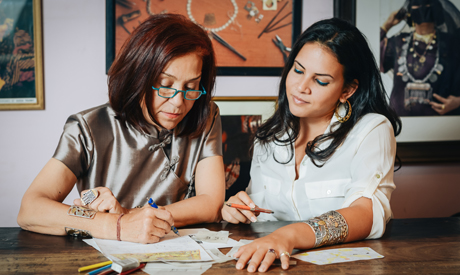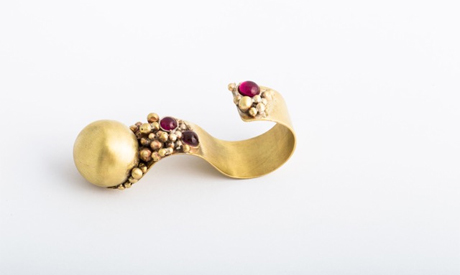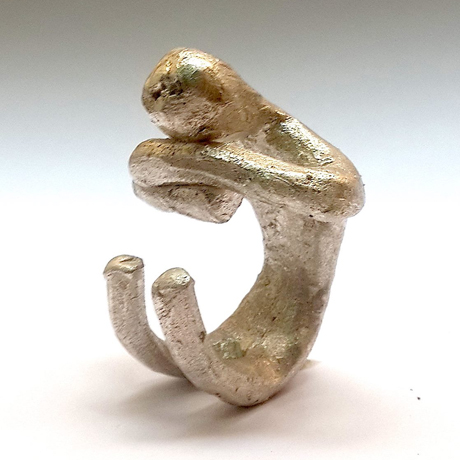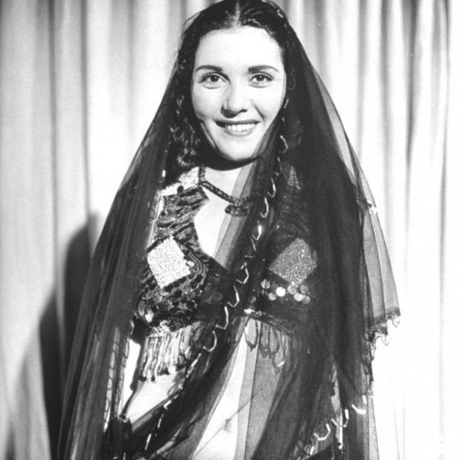On Wednesday afternoon, Dina Soliman and Sarah Zaki — two students-teachers at the Design Studio by Azza Fahmy (DSAF) — were seated in the Sharajah Arts Gallery of the American University in Cairo with a group of students from the graphic design programme, to help them find their way around the fascinating world of jewellery making.
Having joined the school of the leading name of atypical jewllery-making in Egypt some three years ago, Soliman and Zaki were eager to be introduced to the students and their work displayed as part of an exhibit dedicated to Fahmy by the AUC Arts Centre.
The Ripple Effect – Azza Fahmy, Design Retrospective, was closing Wednesday (26 October) after close to two weeks since its inauguration.
It allowed its visitors, from university students to the wider public, a thorough look at the evolution of the work of Fahmy who set a revolutionary trend for jewelery making in Egypt in the late 1970s when she created her first designs. Atypical, Fahmy is now widely celebrated for her jewelery designed along the lines of Nubian architecture and Arabic calligraphy.

Azza Fahmy and Head designer Amina( courtesy of AF)
Visitors to the gallery would not only see the works of Fahmy from consecutive collections – starting with the famous peasant, a little under a decade ago, to the 2016 African collection. They also had a chance to see how the work was conceptualized before it was created with the evolution of hand-drawn designs on pieces of drawing paper and in the pages of endless notebooks displayed in the exhibition.
“This was precisely the way we thought of this exhibition; we wanted to demonstrate the making of beautiful things and not just to display the jewellery, because in a sense, the showing of the evolution of the precious items we are displaying is as inspiring,” said Nagla Samir, director of the Arts Gallery and professor in the graphic design programme established in 2013.
From 2013 onwards, Samir said, the programme has acted to document Arabic cultural figures and Arabic designers.
So far prominent poet Ahmed Fouad Negm and film director Youssef Chahine have been the two documented Arab cultural figures.
The documentation of Arab designers started with painter and designer Helmy El-Touny and continued with Azza Fahmy.
The closure of the exhibit was a chance for Fahmy’s students to pass on the know-how they have been acquiring to yet a younger generation.
“I think it is important to tell those students that there is room today for modern and contemporary designing – it could be strict jewellery designing and it could be about learning how to design accessories to go with clothes for example,” said Zeinab Gaafar from DSAF.
According to Gaafar, for the last three years DSAF has been helping keen men and women who did not have a chance to study and get apprenticeship, “because this is part of what Azza Fahmy had always wanted to do since she started her path back in the 1970s: not just to create space for beautiful jewellery that is well made and that is inspired by a multi-layered heritage, but also to create a milieu for the survival of the trend she set.”
This is why, Gaafar explained, DSAF is offering three types of courses for interested and potential designers, and even working people who wish to develop a talent or indulge in a hobby.
“It is all about beauty really; it is not just about the beauty of a ring or a pair of earrings, but also about the beauty of the material we work with and about the beauty we feel when we create our designs,” said Soliman.

Photos: courtesy of Dina Souliman
It was the beauty of the jewelery coming almost literally from the four corners of the earth to Dubai where she was based as a flight attendant for Emirates airlines that brought Soliman face to face with a long postponed dream of being a jeweler.
And it was the beauty of the precious stones and pearls that Zaki found unattended for long in her mother’s closet, and the beauty of having them assembled with the silver units she hand-picked, that prompted her to turn her back on an established legal-business career and pursue a design course that would feed her passion.

Photos: courtesy of Sara Zaki
“I think this is what this whole issue of graphic design is all about: experimenting with beauty and coming closer to it,” Samir said.
This, she added, was precisely the reason why the exhibits she works on are open to the public.
“We really believe we have to reach out with our message to as many people as possible and to contribute to the work done by others to promote beauty at a very challenging moment of pertaining ugliness,” she argued.
Samir is convinced that the call of beauty has been for long abandoned. “You look around and you see things that are luxurious and big but that are not necessarily beautiful as well. The resumption of the pursuit of beauty is really a mandate to help dispel all this negative energy that we are faced with in our hectic lives,” she argued.
In an ongoing pursuit, Samir is encouraging her students to have a look through “the many elements of the beauty” of 20th century legendary belly-dancer Tahiya Karioka.

Taheya Karyoka
“I don’t at all just mean the actual beauty of Tahiya, or just her belly-dancing costumes and jewelery, but the beauty of her films and her performance and her inner beauty as a true humanitarian and a real patriotic woman,” Samir said.
Looking more deeply, she added, should help students if tasked to redesign some of the posters of her prominent movies, or maybe rework her pictures artistically.
This requires an appreciation for the choreography of Tahiyya Kariokka that would be no less than the appreciation of the calligraphy designs of Azza Fahmy. It also means an appreciation for the contribution that each presented to the wider call of beauty.
“It requires liberation from the disturbing preconceived images that society might have now about a belly-dancer or that society had about a woman apprentice at a workshop in the goldsmith market back in the 1970. Liberation from inhibitions and willingness to open up to see through is the essential requirement for the triumph of beauty over ugliness,” Samir concluded.
Short link: